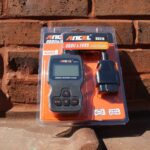When you’re using an OBD2 scanner to diagnose your vehicle’s health, you’ll likely encounter abbreviations and technical terms. One common term is “TP,” which stands for Throttle Position. For car enthusiasts and mechanics alike, understanding what TP means and how to interpret its readings is essential for effective diagnostics and maintenance.
The Throttle Position Sensor (TPS) is a critical component in your vehicle’s engine management system. It continuously monitors the throttle valve’s angle and relays this information to the Engine Control Unit (ECU). But what does this data tell you about your car, and how can you use it to identify potential problems?
This article will delve into the meaning of TP on an OBD2 scanner, explore the function of the TPS, and guide you on how to use TP data for diagnosing vehicle issues using tools like the Foxwell NT1009 scanner. Whether you’re grappling with sluggish acceleration, inconsistent idling, or simply want to understand your vehicle’s throttle system better, this guide provides the insights you need.
TP Meaning OBD2: Unpacking Throttle Position
Alt text: Foxwell NT604 Elite all system car scanner displaying diagnostic data, highlighting its capability for comprehensive vehicle analysis.
In the context of OBD2 scanning, TP unequivocally stands for Throttle Position. This reading, displayed by your OBD2 scanner, indicates the current angle of the throttle valve within your vehicle’s intake system. The throttle valve controls the amount of air flowing into the engine. This is a fundamental parameter for the ECU to manage engine operation effectively.
The ECU relies on the TP reading to determine the appropriate amount of fuel to inject, adjust ignition timing, and control other engine parameters. By knowing the throttle position, the ECU can optimize engine performance, ensuring the engine runs efficiently and responds correctly to driver input.
The component responsible for providing this crucial information is the Throttle Position Sensor (TPS). This sensor is strategically positioned on the throttle body to accurately measure the throttle valve’s opening and transmit this data to the ECU in real-time. Understanding the significance of TP data is your first step toward diagnosing a range of engine performance issues.
The Role of the Throttle Position Sensor (TPS)
The Throttle Position Sensor (TPS) is a potentiometer or a Hall effect sensor that directly measures the position of the throttle valve. It’s typically mounted on the throttle body, where it’s mechanically linked to the throttle valve shaft. As you depress the accelerator pedal, you mechanically open the throttle valve, and the TPS sensor detects this change.
The TPS translates the mechanical movement of the throttle valve into an electrical signal, usually a voltage that varies proportionally with the throttle angle. A closed throttle might read a low voltage, while a fully open throttle would register a high voltage. This voltage signal is then sent to the ECU.
The ECU interprets this voltage signal to understand the driver’s demand for power. Based on the TPS reading, along with input from other sensors like the Mass Air Flow (MAF) sensor and oxygen sensors, the ECU calculates and adjusts:
- Fuel Delivery: More throttle opening means more air entering the engine, requiring more fuel to maintain the ideal air-fuel mixture.
- Ignition Timing: Throttle position influences the engine load and speed, which are key factors in determining optimal ignition timing for efficient combustion.
- Idle Control: Even when your foot is off the accelerator, the TPS helps the ECU maintain a stable idle speed by slightly adjusting the throttle valve position.
A properly functioning TPS is crucial for smooth acceleration, fuel efficiency, and overall engine performance. A faulty TPS can send incorrect signals to the ECU, leading to a cascade of engine performance problems.
How OBD2 Scanners Interpret TP Data
OBD2 scanners, such as the Foxwell NT1009, communicate directly with your vehicle’s ECU through the standardized OBD2 port, typically located under the dashboard. Once connected, the scanner requests and receives real-time data from various sensors, including the TPS.
The scanner then processes this raw data and presents it in a user-friendly format. For TP data, this is usually displayed as a percentage. A TP reading of 0% generally indicates a fully closed throttle (idle position), while 100% signifies a fully open throttle (wide-open throttle). Intermediate percentages represent varying degrees of throttle opening.
Alt text: A person using a Foxwell NT530 car scanner inside a vehicle, demonstrating the practical application of OBD2 diagnostic tools for car maintenance.
Advanced scanners like the Foxwell NT1009 offer live data streaming capabilities. This allows you to monitor the TP value and other engine parameters in real-time as you operate the vehicle. For example, you can observe how the TP percentage changes as you press and release the accelerator pedal. This dynamic monitoring is invaluable for diagnosing intermittent issues or observing throttle response under different driving conditions.
Furthermore, OBD2 scanners can retrieve Diagnostic Trouble Codes (DTCs) stored by the ECU. If the ECU detects a problem with the TPS circuit or its readings, it will often set a DTC and may illuminate the check engine light. The scanner can read these codes, providing specific clues about potential TPS malfunctions.
By using an OBD2 scanner to read TP data, you gain direct insight into how your vehicle’s throttle system is behaving. This information is a powerful starting point for diagnosing drivability problems.
Decoding Abnormal TP Readings: Common Culprits
When your OBD2 scanner displays abnormal TP readings, it signals potential issues within the throttle system or related components. Here are some common causes of erratic or incorrect TP data:
- Faulty Throttle Position Sensor (TPS): The TPS itself can fail due to wear and tear, internal electrical faults, or contamination. A failing TPS might send inaccurate, intermittent, or no signals to the ECU.
- Dirty Throttle Body: Over time, carbon deposits and grime can accumulate inside the throttle body, particularly around the throttle valve. This buildup can restrict the smooth movement of the throttle valve or cause it to stick, leading to incorrect TPS readings.
- Wiring and Connector Problems: The wiring harness connecting the TPS to the ECU can be damaged, corroded, or become loose. Faulty wiring or a poor connector can disrupt the signal transmission, resulting in erratic or absent TP data.
- Throttle Body Actuator Issues (Electronic Throttle Control): In modern vehicles with electronic throttle control (drive-by-wire), a motor (actuator) controls the throttle valve instead of a direct cable. Problems with this actuator or its control circuitry can lead to incorrect throttle valve positioning and abnormal TP readings.
- ECU Malfunction (Less Common): While less frequent, in rare cases, an ECU malfunction could misinterpret TPS signals or cause related diagnostic errors that manifest as abnormal TP readings.
Using a scanner to check TP values and any associated DTCs is the first step in pinpointing the root cause of throttle-related problems.
Diagnosing Vehicle Issues with TP Data: Real-World Scenarios
TP data from your OBD2 scanner is a valuable diagnostic tool for a range of vehicle problems, especially those affecting acceleration, idle stability, and fuel efficiency. Here’s how you can interpret TP readings in common diagnostic scenarios:
- Erratic or Fluctuating TP Values at Steady Throttle: If you observe the TP percentage jumping around erratically on the scanner screen while holding the accelerator pedal steady, this strongly suggests a faulty TPS or wiring issues. The ECU is receiving inconsistent information about throttle position.
- High TP Reading at Idle (Above Expected Range): A consistently high TP reading when the engine is idling and your foot is off the accelerator indicates that the throttle valve is not fully closing. This could be due to a sticking throttle body, excessive carbon buildup, or an improperly adjusted TPS. It can lead to a high idle speed and potential drivability issues.
- Low or No TP Change When Accelerating: If the TP value remains stubbornly low (or doesn’t change at all) even when you press the accelerator pedal, it signifies a problem in the throttle actuation system. This could be a disconnected throttle cable (in older vehicles), a malfunctioning throttle actuator, or a TPS that’s not registering throttle movement. This will result in poor or no acceleration.
- Intermittent Hesitation or Dead Spots During Acceleration: If you experience hesitation or “dead spots” in acceleration, particularly at certain throttle positions, monitoring the TP data during these events can be revealing. A sudden drop or erratic fluctuation in TP reading concurrent with the hesitation points to a TPS issue.
By carefully observing TP data in relation to vehicle symptoms, you can narrow down the potential causes and guide your troubleshooting process effectively.
Symptoms of a Faulty TPS and Repair Strategies
A malfunctioning Throttle Position Sensor (TPS) can manifest in a variety of noticeable symptoms that affect your vehicle’s performance and drivability. Recognizing these symptoms can prompt you to investigate the TPS and utilize your OBD2 scanner for diagnosis. Common signs of a bad TPS include:
- Hesitation or Lagging Acceleration: One of the most typical symptoms is a delay or hesitation when you press the accelerator pedal. The engine may feel sluggish to respond, especially when accelerating from a stop or trying to pass.
- Rough or Unstable Idle: A faulty TPS can cause the engine idle to be erratic. You might experience fluctuating RPMs, an unusually high idle speed, or even engine stalling at idle.
- Check Engine Light Illumination: When the ECU detects inconsistencies or errors in the TPS signal, it will often trigger the check engine light and store a related DTC, such as codes indicating TPS circuit voltage issues or performance problems.
- Poor Fuel Economy: An improperly functioning TPS can lead to incorrect fuel delivery calculations by the ECU. This can result in the engine running richer or leaner than optimal, negatively impacting fuel efficiency and increasing fuel consumption.
- Transmission Shifting Problems (Automatic Transmissions): In vehicles with automatic transmissions, the TPS signal is often used by the transmission control module (TCM) to determine shift points. A faulty TPS can cause erratic or harsh shifting, or incorrect gear selection.
- Stalling: In more severe cases, a failing TPS can cause the engine to stall, particularly at idle or during deceleration.
When addressing TPS-related issues, a systematic approach is best:
- OBD2 Scan: Use a scanner to read TP data and check for DTCs related to the TPS. Note down any trouble codes.
- Visual Inspection: Inspect the TPS wiring and connector for damage, corrosion, or looseness. Check the throttle body for carbon buildup.
- Live Data Monitoring: Use your scanner to monitor live TP data while manually moving the throttle linkage (with the engine off and ignition on). Look for smooth and consistent changes in TP percentage without dropouts or erratic jumps.
- TPS Testing (Multimeter): If you suspect a faulty TPS, you can use a multimeter to test its resistance or voltage output according to your vehicle’s service manual specifications.
- Throttle Body Cleaning: If carbon buildup is present, clean the throttle body thoroughly using a throttle body cleaner.
- TPS Replacement: If the TPS is confirmed to be faulty, replace it with a new, quality sensor. Ensure proper calibration or relearning procedures are followed if required for your vehicle.
- Wiring Repair: If wiring or connector issues are found, repair or replace the damaged components.
Remember to clear DTCs after performing repairs and re-scan to ensure the problem is resolved.
The Impact of TP Data on Overall Vehicle Performance
Throttle Position (TP) data is not just a diagnostic parameter; it’s a fundamental input that profoundly influences your vehicle’s overall performance characteristics. Here’s how TP data directly affects various aspects of vehicle operation:
- Throttle Response and Acceleration Feel: Accurate TP data enables the ECU to precisely control fuel and ignition timing in response to your accelerator pedal input. This results in crisp, predictable, and responsive acceleration. Conversely, faulty TP readings can lead to sluggish, hesitant, or jerky acceleration.
- Fuel Efficiency and Economy: Proper throttle position sensing is crucial for maintaining optimal air-fuel ratios across different engine loads and speeds. A malfunctioning TPS can disrupt this balance, causing the engine to run inefficiently, waste fuel, and reduce your car’s gas mileage.
- Emission Control System Effectiveness: The throttle position is a factor in emission control strategies. An inaccurate TPS signal can cause the engine to run richer or leaner than intended, potentially increasing harmful emissions and possibly causing the vehicle to fail emissions tests.
- Engine Power Output and Drivability: For performance-oriented driving, precise throttle control is essential to access the engine’s full power potential smoothly and predictably. A faulty TPS can limit engine power, create flat spots in the power band, and degrade overall drivability.
- Idle Quality and Stability: TP data plays a role in idle speed control. A properly functioning TPS helps the ECU maintain a smooth and stable idle, preventing stalling and ensuring comfortable stop-and-go driving.
By regularly monitoring TP data with an OBD2 scanner, you can proactively assess the health of your throttle system and address potential issues before they escalate into more significant performance problems or costly repairs.
Conclusion: Leveraging TP Data for Proactive Vehicle Maintenance
Understanding the meaning of “TP” on your OBD2 scanner and how to interpret throttle position readings is a valuable skill for any car owner or automotive enthusiast. The Throttle Position Sensor (TPS) is a small but vital component that plays a significant role in engine management, impacting everything from acceleration and fuel economy to emissions and overall drivability.
Equipping yourself with an OBD2 scanner like the Foxwell NT1009 empowers you to monitor TP data in real-time, diagnose potential throttle system problems early, and make informed decisions about vehicle maintenance and repairs. By paying attention to TP readings and understanding their implications, you can keep your vehicle running smoothly, efficiently, and reliably for years to come.
Explore Further Diagnostic Capabilities
You might also be interested in learning about other key OBD2 parameters and diagnostic procedures to enhance your vehicle maintenance knowledge. Consider exploring topics such as:
- Understanding and diagnosing fuel injector issues with OBD2 scanners.
- Utilizing OBD2 scanners for ABS and brake system diagnostics.
- Advanced diagnostic features of professional-grade OBD2 scanners like the Foxwell NT-series.


